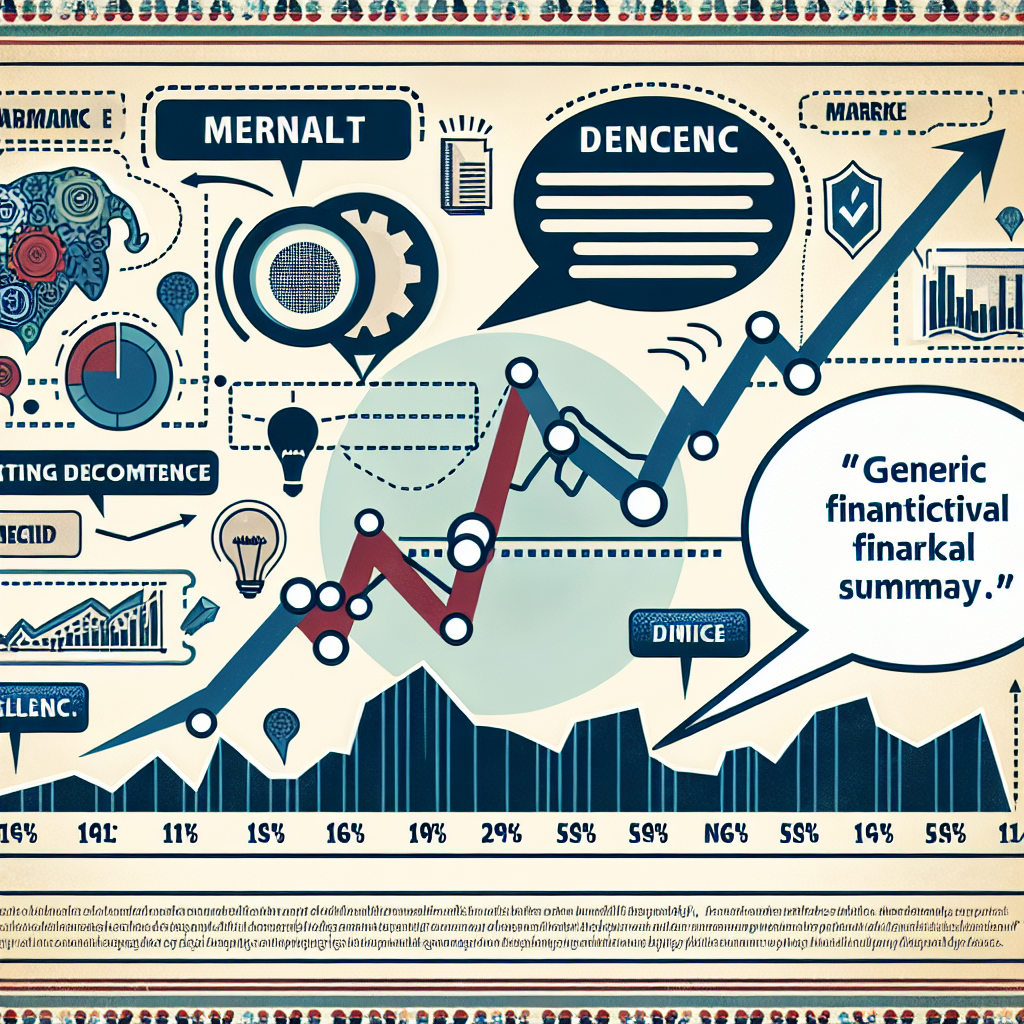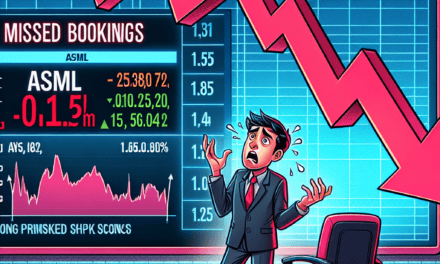“Market Dips: Powell’s Words Send Stocks Tumbling”
Introduction
Stocks experienced a notable decline following comments from Federal Reserve Chair Jerome Powell, which signaled potential shifts in monetary policy. Investors reacted to Powell’s remarks, interpreting them as an indication of future interest rate hikes aimed at curbing inflation. This led to a sell-off across major indices, with technology and growth stocks bearing the brunt of the downturn. The market’s response underscores the sensitivity of investors to policy signals from the Federal Reserve, as they recalibrate their expectations for economic growth and corporate earnings in an environment of tightening financial conditions.
Impact Of Powell’s Comments On Stock Market Trends
In the wake of Federal Reserve Chair Jerome Powell’s recent comments, the stock market experienced a notable decline, reflecting investor apprehension and recalibrated expectations. Powell’s remarks, which emphasized the potential for sustained interest rate hikes to combat persistent inflation, have sent ripples through the financial markets, prompting a reassessment of risk and return among investors. As the Federal Reserve continues to grapple with inflationary pressures, Powell’s statements have underscored the central bank’s commitment to its inflation targets, even at the risk of economic slowdown. This has inevitably led to a shift in market sentiment, as investors weigh the implications of tighter monetary policy on corporate earnings and economic growth.
The immediate impact of Powell’s comments was evident in the stock market’s reaction, with major indices such as the S&P 500, Dow Jones Industrial Average, and Nasdaq Composite all registering declines. This downturn can be attributed to heightened concerns over the cost of borrowing, which could potentially dampen consumer spending and business investment. As interest rates rise, the cost of capital increases, making it more expensive for companies to finance expansion projects and for consumers to take on new debt. Consequently, sectors that are particularly sensitive to interest rate changes, such as technology and consumer discretionary, have borne the brunt of the market’s negative response.
Moreover, Powell’s indication that the Federal Reserve may maintain higher interest rates for an extended period has led to a recalibration of future earnings projections. Investors are now factoring in the possibility of slower economic growth, which could translate into lower corporate profits. This has prompted a reevaluation of stock valuations, with many market participants opting to reduce their exposure to equities in favor of safer assets such as bonds. The bond market, in turn, has seen yields rise as prices fall, reflecting the inverse relationship between bond prices and yields.
In addition to the immediate market reaction, Powell’s comments have also sparked a broader discussion about the long-term trajectory of monetary policy and its implications for the stock market. While some analysts argue that the Federal Reserve’s commitment to curbing inflation is necessary to ensure long-term economic stability, others caution that overly aggressive rate hikes could stifle growth and lead to a recession. This debate has added another layer of complexity to the investment landscape, as market participants attempt to navigate the uncertain path ahead.
Furthermore, Powell’s remarks have highlighted the interconnectedness of global financial markets, as investors around the world respond to shifts in U.S. monetary policy. The ripple effects of the Federal Reserve’s actions are being felt in international markets, with many foreign equities experiencing similar declines. This global response underscores the importance of the U.S. economy in the broader financial ecosystem and the influence of its central bank’s policy decisions on global market trends.
In conclusion, Jerome Powell’s recent comments have had a significant impact on stock market trends, prompting a reassessment of risk and return among investors. As the Federal Reserve signals its intent to maintain higher interest rates to combat inflation, market participants are grappling with the potential implications for economic growth and corporate earnings. This has led to a decline in major stock indices and a shift in investor sentiment, as the market adjusts to the prospect of a more challenging economic environment. As the situation continues to evolve, investors will be closely monitoring further developments in monetary policy and their potential impact on the financial markets.
Analyzing The Market Reaction To Powell’s Statements
In the wake of Federal Reserve Chair Jerome Powell’s recent comments, the stock market experienced a notable decline, prompting investors and analysts to scrutinize the implications of his statements. Powell’s remarks, which were delivered during a closely watched economic symposium, emphasized the Federal Reserve’s commitment to combating inflation, even if it means maintaining higher interest rates for an extended period. This stance, while aimed at stabilizing the economy, has sparked concerns among market participants about the potential impact on economic growth and corporate profitability.
To understand the market’s reaction, it is essential to consider the broader economic context in which Powell’s comments were made. Inflation has been a persistent challenge, with rates remaining above the Federal Reserve’s target for several months. In response, the central bank has implemented a series of interest rate hikes, aiming to curb inflationary pressures. However, these measures have also raised fears of a potential economic slowdown, as higher borrowing costs can dampen consumer spending and business investment.
Powell’s reaffirmation of the Federal Reserve’s hawkish stance was perceived by many investors as a signal that interest rates may remain elevated for longer than previously anticipated. This prospect has led to a reassessment of risk across various asset classes, with equities bearing the brunt of the adjustment. As investors recalibrate their expectations, sectors that are particularly sensitive to interest rate changes, such as technology and consumer discretionary, have experienced significant declines.
Moreover, Powell’s comments have also influenced bond markets, where yields have risen in anticipation of prolonged monetary tightening. Higher bond yields can make equities less attractive by increasing the discount rate applied to future corporate earnings, thereby reducing their present value. Consequently, this dynamic has contributed to the downward pressure on stock prices, as investors seek to realign their portfolios in response to the evolving interest rate environment.
In addition to the immediate market reaction, Powell’s statements have also prompted a broader discussion about the potential long-term implications for the economy. While the Federal Reserve’s commitment to controlling inflation is crucial for maintaining price stability, there is a growing concern that prolonged high interest rates could stifle economic growth. This delicate balancing act between curbing inflation and supporting economic expansion remains a central challenge for policymakers.
Furthermore, Powell’s comments have underscored the importance of clear communication from the Federal Reserve. Market participants rely heavily on guidance from central banks to make informed investment decisions. Any perceived ambiguity or shift in policy stance can lead to heightened volatility, as investors adjust their strategies based on new information. Therefore, maintaining transparency and consistency in messaging is vital to fostering market stability.
In conclusion, the decline in stocks following Powell’s comments reflects the market’s apprehension about the potential consequences of sustained high interest rates. As investors navigate this uncertain landscape, they must weigh the Federal Reserve’s commitment to controlling inflation against the risk of an economic slowdown. While the path forward remains uncertain, the interplay between monetary policy and market dynamics will continue to shape the investment landscape in the coming months. As such, staying informed and adaptable will be key for market participants seeking to navigate these challenging times.
Key Factors Behind The Stock Market Decline
The recent decline in stock markets has captured the attention of investors and analysts alike, following comments made by Federal Reserve Chair Jerome Powell. His remarks, which hinted at the possibility of prolonged high interest rates, have sent ripples through the financial markets, leading to a notable downturn in stock prices. Understanding the key factors behind this decline requires a closer examination of the interplay between monetary policy, investor sentiment, and economic indicators.
To begin with, Powell’s comments have reinforced the Federal Reserve’s commitment to curbing inflation, which remains above the central bank’s target. By suggesting that interest rates may remain elevated for an extended period, Powell has signaled a cautious approach to monetary policy. This stance is primarily driven by the need to ensure that inflationary pressures do not become entrenched in the economy. Consequently, the prospect of higher borrowing costs has raised concerns among investors about the potential impact on corporate profits and economic growth.
Moreover, the anticipation of sustained high interest rates has led to a reassessment of asset valuations. As interest rates rise, the cost of borrowing increases, which can dampen consumer spending and business investment. This, in turn, can lead to slower economic growth and reduced corporate earnings. Investors, therefore, are recalibrating their expectations, leading to a sell-off in equities as they seek to mitigate potential risks. The technology sector, in particular, has been hit hard, as high-growth companies are often more sensitive to changes in interest rates due to their reliance on future earnings.
In addition to Powell’s comments, other economic indicators have contributed to the market’s decline. Recent data on consumer spending and manufacturing output have shown signs of weakening, suggesting that the economy may be losing momentum. These indicators have heightened fears of a potential economic slowdown, further exacerbating the negative sentiment in the stock market. Investors are increasingly wary of the possibility that the Federal Reserve’s efforts to combat inflation could inadvertently tip the economy into a recession.
Furthermore, geopolitical tensions and global economic uncertainties have added another layer of complexity to the market dynamics. Ongoing trade disputes and concerns over supply chain disruptions continue to pose challenges for businesses, potentially affecting their profitability. Additionally, the global economic landscape remains fragile, with varying degrees of recovery across different regions. These factors have contributed to a cautious approach among investors, who are now more inclined to seek safer assets, such as bonds, in times of uncertainty.
Despite these challenges, it is important to note that market fluctuations are a natural part of the economic cycle. While the current decline may be unsettling, it also presents opportunities for investors to reassess their portfolios and identify potential areas for growth. Diversification and a long-term investment strategy remain key principles for navigating volatile markets.
In conclusion, the recent decline in stock markets can be attributed to a confluence of factors, including Powell’s comments on interest rates, weakening economic indicators, and global uncertainties. As investors digest these developments, the focus will likely remain on the Federal Reserve’s policy decisions and their implications for the broader economy. While the path forward may be uncertain, maintaining a balanced perspective and staying informed will be crucial for navigating the evolving market landscape.
Investor Sentiment And Powell’s Economic Outlook

Investor sentiment has been notably impacted following recent comments from Federal Reserve Chair Jerome Powell, which have led to a decline in stock markets. Powell’s remarks, delivered during a closely watched economic symposium, emphasized the ongoing challenges facing the U.S. economy, particularly in terms of inflation and interest rates. As investors digested his insights, the market response was swift, reflecting a cautious outlook on future economic conditions.
Powell’s comments underscored the Federal Reserve’s commitment to its dual mandate of promoting maximum employment and stabilizing prices. However, he highlighted the persistent inflationary pressures that continue to pose a significant challenge. Despite some progress in curbing inflation, Powell noted that it remains above the Fed’s target, necessitating a vigilant approach to monetary policy. This acknowledgment of inflation’s stubbornness has fueled concerns among investors about the potential for prolonged high interest rates, which could dampen economic growth and corporate profitability.
In response to Powell’s remarks, major stock indices experienced a noticeable decline. The Dow Jones Industrial Average, the S&P 500, and the Nasdaq Composite all registered losses, reflecting investor apprehension. The decline was particularly pronounced in sectors sensitive to interest rate fluctuations, such as technology and consumer discretionary stocks. These sectors, which had previously benefited from low borrowing costs, are now facing headwinds as the prospect of sustained higher rates looms.
Moreover, Powell’s comments have reignited debates about the timing and magnitude of future interest rate hikes. While the Federal Reserve has already implemented several rate increases in its effort to combat inflation, Powell’s emphasis on data dependency suggests that further hikes remain on the table. This uncertainty has contributed to heightened market volatility, as investors attempt to gauge the Fed’s next moves and their potential impact on the broader economy.
Adding to the complexity of the situation is the global economic landscape, which remains fraught with challenges. Geopolitical tensions, supply chain disruptions, and varying recovery trajectories across different regions continue to influence investor sentiment. Powell acknowledged these external factors, noting their potential to exacerbate domestic economic pressures. Consequently, investors are increasingly factoring in these global dynamics when assessing the outlook for U.S. markets.
Despite the immediate market reaction, some analysts argue that Powell’s comments should be viewed in a broader context. They point out that the Federal Reserve’s cautious approach is aimed at ensuring long-term economic stability, even if it means short-term market discomfort. By maintaining a focus on inflation control, the Fed aims to prevent the kind of runaway price increases that could undermine economic growth over the long haul. This perspective suggests that while the current market environment may be challenging, it is part of a necessary recalibration process.
In conclusion, Jerome Powell’s recent comments have undeniably influenced investor sentiment, leading to a decline in stock markets. His emphasis on the persistent challenges posed by inflation and the potential for further interest rate hikes has introduced a degree of uncertainty that is reflected in market movements. However, it is important to recognize that the Federal Reserve’s actions are guided by a commitment to long-term economic stability. As investors navigate this complex landscape, they must weigh short-term market fluctuations against the broader goal of sustainable growth.
Sector-Specific Effects Of Powell’s Remarks
Federal Reserve Chair Jerome Powell’s recent comments have sent ripples through the financial markets, leading to a notable decline in stock prices. His remarks, which hinted at the possibility of prolonged interest rate hikes to combat inflation, have had sector-specific effects that are worth examining. As investors digest the implications of Powell’s statements, it becomes evident that different sectors are responding in varied ways, reflecting their unique sensitivities to interest rate changes.
To begin with, the technology sector, often characterized by its high growth potential and reliance on future earnings, has been particularly vulnerable to Powell’s comments. Higher interest rates tend to increase the cost of borrowing, which can dampen the growth prospects of tech companies that rely heavily on debt financing for expansion. Consequently, tech stocks have experienced a sharper decline compared to other sectors. Investors are recalibrating their expectations, factoring in the potential for increased costs and slower growth, which has led to a sell-off in this sector.
In contrast, the financial sector has shown a more resilient response to the prospect of rising interest rates. Banks and other financial institutions often benefit from higher rates, as they can charge more for loans, thereby increasing their profit margins. As a result, while the broader market has faced downward pressure, financial stocks have managed to hold their ground better than most. This divergence highlights the sector’s unique position in the economic landscape, where interest rate hikes can be a double-edged sword, offering both challenges and opportunities.
Meanwhile, the consumer goods sector is grappling with its own set of challenges in light of Powell’s remarks. Companies in this sector are often sensitive to changes in consumer spending, which can be influenced by interest rate adjustments. Higher rates can lead to increased borrowing costs for consumers, potentially reducing their disposable income and, consequently, their spending on non-essential goods. This has led to a cautious outlook for consumer goods companies, as they brace for potential shifts in consumer behavior that could impact their bottom lines.
The energy sector, on the other hand, presents a more complex picture. While higher interest rates can increase operational costs for energy companies, particularly those involved in capital-intensive projects, the sector is also influenced by global oil prices and geopolitical factors. Powell’s comments have added another layer of uncertainty, prompting investors to reassess their positions in energy stocks. The interplay between interest rates and external factors makes this sector’s response more nuanced, as it navigates a landscape shaped by both domestic monetary policy and international dynamics.
Lastly, the real estate sector is feeling the pinch of Powell’s remarks, as higher interest rates directly impact mortgage rates and, by extension, housing affordability. Real estate companies and REITs (Real Estate Investment Trusts) are facing increased scrutiny from investors, who are concerned about the potential slowdown in the housing market. The sector’s sensitivity to interest rate changes underscores the broader implications of Powell’s comments, as market participants weigh the potential for a cooling real estate market against the backdrop of ongoing economic adjustments.
In conclusion, Jerome Powell’s recent comments have had a profound impact on various sectors, each responding in its own way to the prospect of sustained interest rate hikes. As the market continues to adjust to this new reality, investors are closely monitoring sector-specific developments, seeking to navigate the challenges and opportunities that lie ahead. The diverse responses across sectors underscore the complexity of the financial landscape, where interest rate changes can have far-reaching and varied effects.
Historical Context: Powell’s Influence On Market Movements
Jerome Powell, the Chair of the Federal Reserve, has long been a pivotal figure in influencing market movements, with his comments often serving as a catalyst for significant shifts in stock prices. Historically, Powell’s statements have been closely scrutinized by investors and analysts alike, as they provide critical insights into the Federal Reserve’s monetary policy direction. This influence can be traced back to his initial appointment as Chair in February 2018, when markets were eager to understand his approach to interest rates and economic stability. Over the years, Powell’s remarks have consistently demonstrated the power to sway investor sentiment, reflecting the broader economic landscape and the Federal Reserve’s response to evolving conditions.
In the early days of his tenure, Powell’s comments were often interpreted as hawkish, particularly when he signaled a series of interest rate hikes aimed at normalizing monetary policy following the financial crisis of 2008. This stance initially led to market volatility, as investors adjusted their portfolios in anticipation of tighter financial conditions. However, Powell’s ability to communicate the rationale behind these decisions helped to gradually stabilize market reactions, as stakeholders gained confidence in the Federal Reserve’s commitment to balancing growth and inflation.
As the global economy faced unprecedented challenges with the onset of the COVID-19 pandemic in 2020, Powell’s influence on market movements became even more pronounced. His swift and decisive actions, including slashing interest rates to near-zero levels and implementing large-scale asset purchases, were instrumental in calming financial markets during a period of extreme uncertainty. Powell’s assurances of continued support for the economy provided a much-needed anchor for investors, leading to a remarkable recovery in stock prices despite the ongoing health crisis.
In recent times, Powell’s comments have continued to play a crucial role in shaping market dynamics, particularly as the Federal Reserve navigates the complex task of tapering its accommodative policies amid rising inflationary pressures. His statements regarding the timing and pace of interest rate hikes are closely monitored, as they offer valuable clues about the central bank’s strategy for managing economic growth and price stability. Consequently, any perceived shift in Powell’s tone or language can trigger immediate reactions in the stock market, as investors recalibrate their expectations based on the anticipated trajectory of monetary policy.
The latest decline in stocks following Powell’s comments underscores the enduring impact of his words on market sentiment. As he addressed concerns about inflation and the potential need for more aggressive rate hikes, investors responded by reassessing their risk exposure, leading to a broad-based sell-off. This reaction highlights the delicate balance that Powell must maintain in communicating the Federal Reserve’s intentions, as even subtle nuances in his language can have far-reaching implications for financial markets.
In conclusion, Jerome Powell’s influence on market movements is deeply rooted in his role as a key architect of monetary policy. His ability to articulate the Federal Reserve’s objectives and strategies has been instrumental in guiding investor expectations and fostering market stability. As the economic landscape continues to evolve, Powell’s comments will remain a focal point for market participants, serving as a barometer for the future direction of monetary policy and its impact on stock prices.
Strategies For Investors Amidst Market Volatility
In the wake of Federal Reserve Chair Jerome Powell’s recent comments, the stock market has experienced a notable decline, leaving investors to grapple with heightened volatility. Powell’s remarks, which hinted at the possibility of prolonged interest rate hikes to combat inflation, have sent ripples through the financial markets, prompting a reassessment of investment strategies. As investors navigate this turbulent landscape, it becomes imperative to adopt strategies that not only mitigate risk but also capitalize on potential opportunities.
To begin with, diversification remains a cornerstone strategy for investors seeking to weather market volatility. By spreading investments across various asset classes, sectors, and geographic regions, investors can reduce the impact of adverse movements in any single market segment. This approach not only helps in managing risk but also positions investors to benefit from growth in different areas of the economy. For instance, while technology stocks may face headwinds due to rising interest rates, sectors such as energy or consumer staples might offer more stability and potential upside.
Moreover, maintaining a long-term perspective is crucial during periods of market uncertainty. Short-term fluctuations, often driven by macroeconomic factors or geopolitical events, can lead to impulsive decision-making. However, history has shown that markets tend to recover over time, rewarding those who remain patient and committed to their investment goals. By focusing on the fundamentals of their investments and avoiding knee-jerk reactions, investors can better navigate the ups and downs of the market.
In addition to diversification and a long-term outlook, investors should consider incorporating defensive stocks into their portfolios. These stocks, typically found in sectors such as utilities, healthcare, and consumer goods, tend to be less sensitive to economic cycles and can provide a buffer against market volatility. Their stable earnings and dividends make them attractive options for those seeking to preserve capital while still generating income.
Furthermore, the current market environment presents an opportunity for investors to reassess their risk tolerance and adjust their portfolios accordingly. With interest rates on the rise, fixed-income investments such as bonds may offer more attractive yields than they have in recent years. By increasing exposure to high-quality bonds, investors can enhance the stability of their portfolios while still achieving a reasonable return.
Another strategy worth considering is the use of dollar-cost averaging, which involves investing a fixed amount of money at regular intervals, regardless of market conditions. This approach can help investors avoid the pitfalls of trying to time the market and reduce the impact of volatility on their portfolios. Over time, dollar-cost averaging can lead to a lower average cost per share, potentially enhancing returns when markets recover.
Finally, staying informed and seeking professional advice can be invaluable during times of market turbulence. By keeping abreast of economic developments and understanding their potential impact on investments, investors can make more informed decisions. Additionally, consulting with financial advisors can provide personalized guidance tailored to individual circumstances and goals.
In conclusion, while Powell’s comments have undoubtedly contributed to recent market declines, they also serve as a reminder of the importance of strategic planning in investing. By embracing diversification, maintaining a long-term perspective, incorporating defensive stocks, reassessing risk tolerance, utilizing dollar-cost averaging, and seeking professional advice, investors can navigate the current volatility with greater confidence and poise.
Q&A
1. **What caused the stock market to decline?**
The stock market declined following comments from Federal Reserve Chair Jerome Powell, which suggested potential future interest rate hikes to combat inflation.
2. **How did Powell’s comments impact investor sentiment?**
Powell’s comments led to increased investor anxiety about tighter monetary policy, which could slow economic growth and impact corporate earnings.
3. **Which sectors were most affected by the decline?**
Interest rate-sensitive sectors such as technology and consumer discretionary were among the most affected, as higher rates can reduce the present value of future earnings.
4. **What was the immediate market reaction to Powell’s comments?**
Major stock indices, such as the S&P 500 and the Dow Jones Industrial Average, experienced a noticeable drop shortly after Powell’s remarks.
5. **Did Powell provide any specific guidance on future rate hikes?**
Powell did not provide specific guidance on the timing or magnitude of future rate hikes but emphasized the Fed’s commitment to controlling inflation.
6. **How did bond markets react to Powell’s comments?**
Bond yields rose as investors anticipated higher interest rates, which typically lead to lower bond prices.
7. **What are analysts predicting for the market’s short-term outlook?**
Analysts predict continued volatility in the short term as markets adjust to the possibility of more aggressive monetary policy from the Federal Reserve.
Conclusion
Federal Reserve Chair Jerome Powell’s recent comments have led to a decline in stock markets, as investors reacted to potential implications for monetary policy. Powell’s remarks, which may have signaled a more hawkish stance on interest rates or economic outlook, prompted concerns about tighter financial conditions. This uncertainty has resulted in a sell-off across various sectors, reflecting investor apprehension about future economic growth and corporate earnings. The market’s response underscores the sensitivity of financial markets to central bank communications and the ongoing balancing act between curbing inflation and supporting economic expansion.





